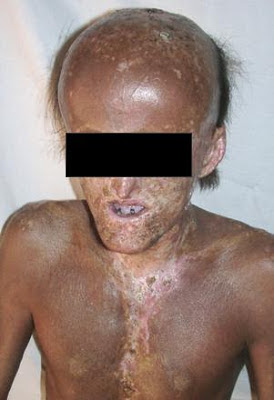 |
| Congenital erythropoietic porphyria |
The release of the film The Madness of King George has brought the disease of porphyria full in the public domain. From the first signs of the King's illness, his gastrointestinal distress, his blue-tinged urine, to his complete mental collapse and subsequent, almost miraculous, recovery, the film paints a classic portrait of porphyria. However, the use of this rare disease to explain one of history's great abberations has also been extrapolated by the media, and erroneously so, to the realm of the vampire.
Although a fascinating concept, for most of us today, the vampire is a myth, easily dismissed as mere fiction to be enjoyed at the cinema or on the printed page. However, during the 18th century, the age of the folkloric or mythic vampire, Eastern Europe in particular, was rife with reports of vampire citings. So prevalent was the belief in the existence of a literal vampire, that the Austrians, occupying Serbia during the 1730s, dispatched a team of medical officers to a Serbian town to investigate the weekly exhumations and 'killing' of the dead.'
One modern but now prevalent explanation of the myth can be summed up in one word, porphyria. The genesis of this theory might have begun in an article in the News York Times in May 1985. In a speech to the American Association for the Advancement of Science, Dr David H Dolphin announced that 'werewolves and vampires those dreaded beasts of folklore and superstition, may have been nothing more than people suffering from a rare class of genetic disease'.' He went on to say that signs and symptoms commonly associated with vampirism, ie, protruding teeth, avoidance of sunlight, drinking blood, and (sometimes) disfigurement, could have been exhibited by sufferers of porphyria.
Classed by their exhibition of symptoms in two ways, neurological and photosensitive (dermatological), the porphyrias, a group of rare genetic and acquired diseases of the blood, result when the production and synthesis of haemoglobin go awry.3'4 The rarest and most horrific form of the porphyrias, which is not only considered a viable explanation for vampires but also doubles quite nicely for werewolves, is congenital erythropoietic porphyria. Not more than 200 cases have so far been diagnosed.5 Beginning in early childhood, congenital erythropoietic porphyria anifests itself in extreme sensitivity to light (sun). On exposure to light the skin blisters, and with infection can become so severely scarred as to leave the individual quite disfigured. Treatment for sufferers could involve blood transfusions, but the only effective treatment is bone marrow transplantation.6,7
On the surface, the vampiristic aspects of congenital erythropoietic porphyria are quite evident. Avoidance of sunlight and the need to ingest blood, as Dr Dolphin suggests, may have driven its victims to 'suck the blood of their brothers and sisters'. However, the folkloric vampire was a very different creature to the one we are generally familiar with in the 20th century. An important difference
was the belief that it was not uncommon for the vampire to be active out-of-doors while the sun shone. In 18th and 19th century Europe there were accounts ofvampire citings occurring in daylight hours.8 Even Stoker's Dracula was observed taking an afternoon stroll through London's crowded streets.
As it was believed that the folkloric vampire could move about freely in daylight hours, as opposed to the 20th century variant, congenital erythropoietic porphyria cannot readily explain the folkloric vampire but may be an explanation of the vampire as we know it in the 20th century. In addition, the folkloric vampire, when unearthed, was always described as looking quite healthy ('as they were in life'), while due to the disfiguring aspects of the disease, sufferers would not have passed the exhumation test. Individuals with congenital erythropoietic porphyriado not crave blood. The enzyme (haematin) necessary to alleviate the symptoms is not absorbed intact on oral ingestion, and drinking blood would have no beneficial effect for the sufferer.9 Finally, and most important, the fact
that vampire reports were literally rampant in the 18th century, and that congenital erythropoietic porphyria is an extremely rare manifestation of a rare disease, makes it an unlikely explanation of the folkloric vampire.
1 Barber P. The real vampire: forensic pathology and the lore of the undead.
Nat Hist 1990; (October) 74-83.
2 Boffey PM. Rare disease proposed as cause for 'vampire'. New York Times 31
May, 1985; A15.
3 Meola T, Lim HW. The porphyrias. Dermatol Clin 1993; 11: 583-96.
4 Moore MR. Biochemistry of porphyria. Int J Biochem 1993; 25: 1353-68.
5 Kushner JP. Laboratory diagnosis of the porphyrias. N EngI J Med 1991;
324: 1432-4.
6 Hoffnan R, ed. Hematology: basic principles and practice. New York:
Churchill Livingstone, 1991; p 357.
7 Kauppinen R, Timomen K, Mustajoki P. Treatment of the porphyrias. Ann
Med 1994; 26: 31-8.
8 Copper B. The vampire in legend, fact and art. Secaucus, NJ: The Citadel
Press, 1974; pp 154-6.
9 Winkler G, Anderson KE. Vampires, porphyria, and the media: medicalization
of a myth. Perspect Biol Med 1990; 33: 598-611.
Nat Hist 1990; (October) 74-83.
2 Boffey PM. Rare disease proposed as cause for 'vampire'. New York Times 31
May, 1985; A15.
3 Meola T, Lim HW. The porphyrias. Dermatol Clin 1993; 11: 583-96.
4 Moore MR. Biochemistry of porphyria. Int J Biochem 1993; 25: 1353-68.
5 Kushner JP. Laboratory diagnosis of the porphyrias. N EngI J Med 1991;
324: 1432-4.
6 Hoffnan R, ed. Hematology: basic principles and practice. New York:
Churchill Livingstone, 1991; p 357.
7 Kauppinen R, Timomen K, Mustajoki P. Treatment of the porphyrias. Ann
Med 1994; 26: 31-8.
8 Copper B. The vampire in legend, fact and art. Secaucus, NJ: The Citadel
Press, 1974; pp 154-6.
9 Winkler G, Anderson KE. Vampires, porphyria, and the media: medicalization
of a myth. Perspect Biol Med 1990; 33: 598-611.
ANN M COX
McGill University,
Montreal, Quebec H3A 1 YJ Canada

No comments:
Post a Comment